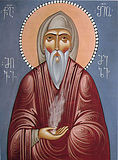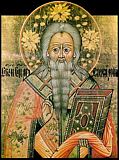

| Previous day | Next day |
| Old Style
February 10
|
Thursday |
New Style
February 23
|
| Cheese-fare Week—no meat; fish and dairy allowed. Tone 3. | Cheese-fare Week—no meat.
|
![]() Hieromartyr Charalampus, bishop of Magnesia in Asia Minor, and Martyrs Porphyrius and Baptus (202).
Hieromartyr Charalampus, bishop of Magnesia in Asia Minor, and Martyrs Porphyrius and Baptus (202).
Martyrs Ennatha, Valentina, and Paula, of Palestine (308). St. Shio of Mgvime, monk, of Georgia (6th c.). St. Anna of Novgorod (1050). St. Prochorus of the Kiev Caves (1107). St. Longinus, founder of Koryazhemka Monastery (Vologda) (1540). St. Raphael, archimandrite (1765), and St. Ioannicius, hieromonk (1882), of Svatogorsk Monastery. Synaxis of Novgorod Hierarchs: Sts. Joachim (1030), Luke the Jew (1060), Germanus (1095), Arcadius (1162), Gregory (1193), Martyrius (1199), Anthony (1231), Basil (1352), Moses (1362), Symeon (1421), Gennadius (1504), Pimen (1571), and Athonius (1653).
“Areovindus” (“Fiery Vision”) Icon of the Most Holy Theotokos.
St. Scholastica of Italy (543), sister of St. Benedict of Nursia. St. Anastasius II, patriarch of Jerusalem (706). St. John Chimchimeli of Bachkovo and Gremi (13th c.).
Thoughts for Each Day of the Year
According to the Daily Church Readings from the Word of God
By St. Theophan the Recluse

Thursday. [Jude 1:11–25; Luke 23:1–34, 44–56]
Woe, proclaims the Holy Apostle Jude, to them who conduct themselves temptingly in society, who without fear fatten themselves at feasts, who foam out their own shame, walk after their own lusts, speak great swelling words and separate themselves from the unity of the faith. Woe! For behold, the Lord will come with ten thousands of His holy angels, to execute judgement upon all, and to expose all that are ungodly in all their ungodly deeds which their ungodliness has committed (cf. Jude 1:11–19).
Articles
 Hieromartyr Charalampus (Haralambos) the Bishop of Magnesia in ThessalyDespite the bishop’s advanced age (he was 113 years old), he was subjected to monstrous tortures. |
 Martyr Porphyrius in ThessalySaint Porphyrius was a soldier who suffered martyrdom with Saints Charalampus, Bishop of Magnesia, |
 Martyr Baptus in ThessalySaint Baptus was a soldier who suffered martyrdom with Saints Charalampus, Bishop of Magnesia, Porphyrius, and three women in the year 202. |
 Martyrs Ennatha, Valentina, and Paula, of PalestineThe Holy Virgin Martyrs Ennatha, Valentina and Paula suffered in the year 308 under the emperor Maximian II Galerius (305-311). |
 Icon of the Mother of God “Areovindus”The origins of this unusual icon, in which the Most Holy Theotokos is depicted without Christ, are unknown. |








